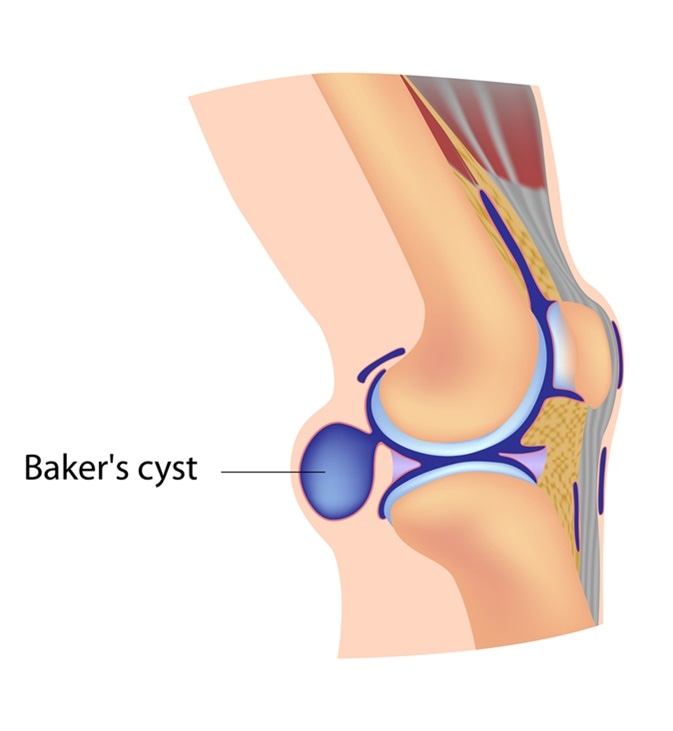A Baker's cyst is also called a popliteal cyst and is a sac filled with fluid that forms behind the knee, because of swelling of the gastrocnemius-semimembranosus bursa. It causes the skin to bulge and feel tight at this spot.

Causes
In adults, communication between the Baker’s cyst and the knee joint cavity is common, and the cyst is usually a complication of knee joint disease such as a meniscal tear, knee joint trauma or arthritis, or rheumatic conditions. Other causes include cartilage tears, joint infections, and some forms of synovitis. They are most often found between the ages of 35 and 70 years.
In children, the cysts are primary and do not communicate with the knee joint, unless associated with knee joint disease or injury. They are most common between 4 and 7 years.
Symptoms
Because they are often asymptomatic, Baker’s cysts may be detected on examination or while imaging for some other disorder. Sometimes it is painful or uncomfortable, especially when the knee is used, and may prevent the joint from flexing or extending completely. Foucher’s sign refers to the disappearance of the cyst at 45 degrees flexion of the knee.
How it occurs
A Baker’s cyst occurs because:
- Joint fluid leaks into the cyst, keeping it from collapsing
- Synovial fluid collects within the popliteal fossa, as the gastrocnemius and semimembranosus muscle forces it into the cyst as the knee flexes and extends
- The knee pressure drops during partial flexion, and increases during extension, thus pushing fluid into the cyst from the suprapatellar bursa during knee flexion
- The gastrocnemius-semimembranosus bursa grows larger as it develops small tears during muscle contraction
- The joint capsule herniates into the popliteal fossa
Complications
Though uncommon, a Baker’s cyst may cause some complications such as:
- Pressure upon the surrounding veins, causing the lower limb to swell
- It may dissect into the calf muscle causing acute pain, redness, swelling and positive Homan’s sign as in deep vein thrombosis
- Rupture of a Baker’s cyst can cause inflammatory symptoms with pain and swelling of the calf and knee, and a strange feeling that water is running down the calf
- Thrombophlebitis, nerve entrapment, popliteal artery obstruction, and anterior or posterior compartment syndrome are other complications
- Loose bodies may occur within the cyst and may migrate into the joint cavity if it communicates with the cyst
Diagnosis
Baker’s syndrome is diagnosed by the history and physical examination with the knee in full extension, and a positive Foucher’s sign. If uncertain as to the diagnosis, the physician may request imaging with an X-rays, ultrasound and MRI scanning particularly if surgery is being planned.
Management
In most cases, the cyst is asymptomatic, and treatment is not required. For mild symptoms, rest, elevation of the limb, and avoiding hard exercise, will lead to cyst resolution over time. However, severe symptoms may require arthroscopic excision or aspiration of the cyst. Corticosteroid injections are also useful. Underlying disorders should be treated appropriately.
Sources
- https://www.ncbi.nlm.nih.gov/pmc/articles/PMC4481672/
- https://www.ncbi.nlm.nih.gov/pmc/articles/PMC4799332/
- https://www.ncbi.nlm.nih.gov/books/NBK430774/
- www.mayoclinic.org/…/syc-20369950
- https://www.nhs.uk/conditions/Bakers-cyst/
Further Reading
- All Cyst Content
- Cysts of the Jaws
- Dentigerous Cysts
- Gingival Cysts in Newborns
Last Updated: Feb 26, 2019

Written by
Dr. Liji Thomas
Dr. Liji Thomas is an OB-GYN, who graduated from the Government Medical College, University of Calicut, Kerala, in 2001. Liji practiced as a full-time consultant in obstetrics/gynecology in a private hospital for a few years following her graduation. She has counseled hundreds of patients facing issues from pregnancy-related problems and infertility, and has been in charge of over 2,000 deliveries, striving always to achieve a normal delivery rather than operative.
Source: Read Full Article
